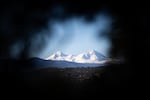People seeking any shred of normalcy as 2020 ends can find one in Oregon’s snowpack.
Oregon is heading into the new year with close to normal levels of snowpack statewide, according to the Natural Resources Conservation Service with the U.S. Department of Agriculture.

North Sister and Middle Sister are seen from Pilot Butte in Bend, Ore., Wednesday, Dec. 23, 2020. Snowpack is near normal levels across much of the state at the end of the calendar year.
Bradley W. Parks / OPB
“That’s a good sign,” said Scott Oviatt, the snow survey supervisory hydrologist with NRCS in Portland. “We have room for improvement, obviously.”
Related: Western snowpack has resisted climate change thus far, but it won't last forever
Snowpack is one indicator of how much water will be available in Oregon come spring. Oregon will start 2021 with nearly 70% of the state experiencing severe drought or worse. Many parts of the state will still fall far short of their average annual precipitation.
“We are a little concerned, and we will remain concerned as long as we’re running that long-term deficit,” Oviatt said. “Because it takes above-normal precipitation and above-normal snow accumulation to mitigate those deficits.”
Lake County in south-Central Oregon had barely exceeded half of its average annual precipitation by late December. The same can be said for the Owyhee Basin bordering Idaho and Nevada. Several other parts of Oregon are also running well short of annual averages.
The Northwest is in a La Niña winter, which usually signals above-average precipitation and could help parts of the state make up deficits.
“Confidence is pretty high that the winter months will be wetter than normal,” said Tyler Kranz, a meteorologist with the National Weather Service in Portland.
Related: Climate change set the conditions for Oregon wildfires, but did it stoke the flames too?
Signs point to above-normal snowpack by spring, but we’re still a long way away from knowing how that will shape summer in Oregon. Last year, for example, high temperatures in the spring and early summer spirited away above-normal snowpack achieved in the winter.
“So the benefits of the snowmelt runoff that we would hope to see were accelerated,” Oviatt said. “The water supply and surface water was not available later in the year.”
The Natural Resources Conservation Service plans to release its first water supply report for 2021 on Friday, Jan. 1.
